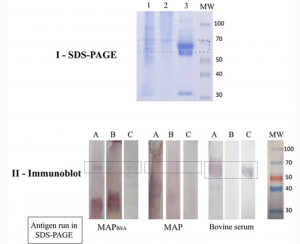The ability to bind albumin is a well-recognized characteristic of many bacteria. In recent paper, researchers show for the first time, the ability of mycobacteria, in particular Mycobacterium avium subsp. paratuberculosis (Map) to bind albumin (Figure 1). This bacterium can cause a chronic inflammatory bowel disease in ruminants, called paratuberculosis or Johne’s disease. Liquid media containing bovine serum albumin (BSA) are frequently used to culture Map in the laboratory.

Figure 1: Antigenic characterization of MAP grown in BSA-containing medium (MAPBSA) by SDS-PAGE and immunoblot. Panel I: Coomassie Blue stained 12% acrylamide SDS-PAGE. Antigens: sonicated MAPBSA (lane 1); sonicated MAP (lane 2); bovine serum (lane 3). Panel II: Immunoblot using MAPBSA, (left panel), MAP (central panel) or bovine serum (right panel) as antigens, and different rabbit sera (at 1:100 dilution): vacMAPBSA (lane A); vacMAP (lane B); vacBSA (lane C). In all cases, HRP polyclonal anti-rabbit IgG (H + L) antibody was used in a 1:3000 dilution. MW: molecular marker containing prestained bands of 100, 70, 50, 40, and 30 kDa (Blue Plus® II Protein Marker, TransGen Biotech Co., LTD.). Dotted boxes show BSA band in panel I or its recognition by antibodies in panel II.
The researchers found that Map cultured in media containing BSA or even incubated with BSA for only a few minutes binds to it with great avidity, since BSA could be detected adhering to the Map surface (using specific antibodies) even after disruptive incubation with urea, a chaotropic agent.
They hypothesized that the ability of Map to bind to albumin could be an evolutionary acquired mechanism of adaptation to its natural host. In fact, this ability could be involved in antigen masking strategies, in order not to be recognized by host antibodies.
Further studies are needed to understand the implications of this interaction between Map and BSA. Beyond that, they suggest that this ability needs to be taken into account when culturing Map in vitro, when performing immunological techniques involving Map as an antigen and BSA as a buffer component, or in the case of performing mouse immunization protocols to produce monoclonal antibodies.
Journal article: Jolly, A., et al., 2023. Evidence of Mycobacterium avium subsp. paratuberculosis binding to albumin: technical and biological implications, Research in Veterinary Science.
Summary by Giselle Ingratta










